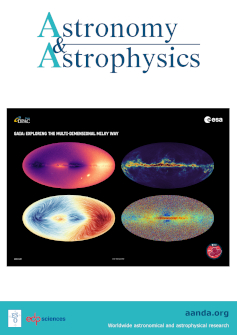Studying the diffusion mechanism of cosmic-ray particles
IF 5.4
2区 物理与天体物理
Q1 ASTRONOMY & ASTROPHYSICS
引用次数: 0
Abstract
Context. An increasing number of observations have indicated the existence of slow diffusion phenomena in astrophysical environments, such as around the supernova remnants and pulsar γ-ray halos, where the diffusion coefficient of cosmic rays (CRs) near the source region is significantly smaller than that far away from the source region. The inhomogeneous diffusion indicates the existence of multiple diffusion mechanisms.Aims. Comparing the CR mirror diffusion with the scattering diffusion, our aim is to explore their diffusion characteristics in different magnetohydrodynamic (MHD) turbulence regimes and understand the effect of different MHD modes on mirror and scattering diffusion.Methods. We performed numerical simulations with the test particle method. Within the global frame of reference, we first measured parallel and perpendicular CR diffusion and then determined the mean free path of CRs with varying energies.Results. Our main results demonstrate that (1) CRs experience a transition from superdiffusion to normal diffusion; (2) mirror diffusion is more important than scattering diffusion in confining CRs; (3) CR diffusion strongly depends on the properties of MHD turbulence; and (4) magnetosonic and Alfvén modes respectively dominate the parallel and perpendicular diffusion of CR particles.Conclusions. The diffusion of CRs is a complex problem of mixing the mirror diffusion and scattering diffusion. The property of turbulent magnetic fields influences CR diffusion. The CR slow diffusion due to the presence of magnetic mirrors in turbulence has important implications for explaining observations near a CR source.研究宇宙射线粒子的扩散机制
上下文。越来越多的观测表明,在超新星遗迹和脉冲星γ射线晕周围等天体物理环境中存在慢扩散现象,在这些环境中,宇宙射线在源区域附近的扩散系数明显小于远离源区域的扩散系数。非均匀扩散表明存在多种扩散机制。通过对CR反射扩散和散射扩散的比较,探讨了它们在不同磁流体动力学(MHD)湍流状态下的扩散特性,并了解不同磁流体动力学模式对反射扩散和散射扩散的影响。采用试验粒子法进行了数值模拟。在全局参照系内,我们首先测量了平行和垂直CR扩散,然后确定了不同能量CR的平均自由程。我们的主要研究结果表明:(1)cr经历了从超扩散到正扩散的过渡;(2)反射扩散比散射扩散更重要;(3) CR扩散强烈依赖于MHD湍流特性;(4) CR粒子的平行扩散和垂直扩散分别以磁子和alfvsamn模式为主。CRs的扩散是一个混合了镜面扩散和散射扩散的复杂问题。湍流磁场的性质影响CR的扩散。由于湍流中磁镜的存在,CR缓慢扩散对解释CR源附近的观测具有重要意义。
本文章由计算机程序翻译,如有差异,请以英文原文为准。
求助全文
约1分钟内获得全文
求助全文
来源期刊

Astronomy & Astrophysics
地学天文-天文与天体物理
CiteScore
10.20
自引率
27.70%
发文量
2105
审稿时长
1-2 weeks
期刊介绍:
Astronomy & Astrophysics is an international Journal that publishes papers on all aspects of astronomy and astrophysics (theoretical, observational, and instrumental) independently of the techniques used to obtain the results.
 求助内容:
求助内容: 应助结果提醒方式:
应助结果提醒方式:


